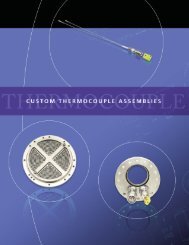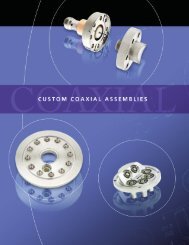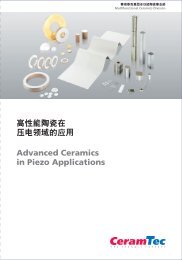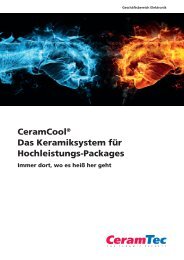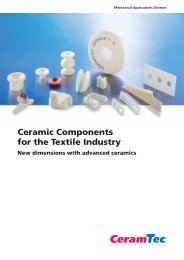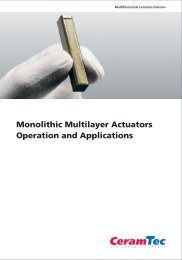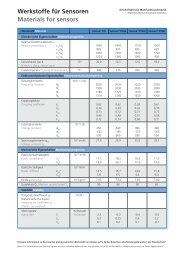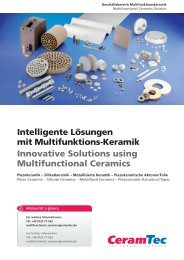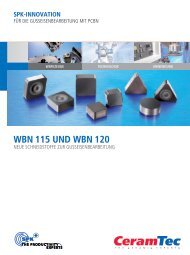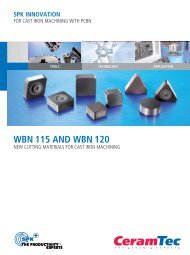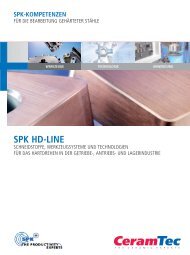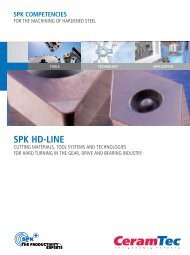Multipin Connector - CeramTec
Multipin Connector - CeramTec
Multipin Connector - CeramTec
You also want an ePaper? Increase the reach of your titles
YUMPU automatically turns print PDFs into web optimized ePapers that Google loves.
Advanced Ceramic-to-Metal & Glass-Ceramic Sealing Technology<br />
The Company — The Technology<br />
<strong>CeramTec</strong> began pioneering ceramic-tometal<br />
technology in 1951 and has been the<br />
leader in providing innovative solutions for<br />
demanding applications ever since. When<br />
faced with a design challenge, our engineers<br />
optimize materials and seal configurations to<br />
minimize stresses and produce highreliability<br />
hermetic assemblies. Manufacturing<br />
personnel at <strong>CeramTec</strong> use state-of-the-art<br />
www2.ceramtec.com<br />
coating and metallizing equipment, and then<br />
utilize one of our many vacuum or atmosphere<br />
furnaces to process anything from the<br />
tiniest feedthrough to eight foot long isolators.<br />
Our systems are continuously upgraded<br />
with solid-state devices to ensure accurate<br />
temperature and process control.<br />
North American Operations<br />
One Technology Place<br />
Laurens, SC 29360<br />
Phone: (864) 682-3215<br />
Toll Free: (800) 752-SEAL (7325)<br />
Fax: (864) 682-1140<br />
Email: sales@ceramtec.com<br />
Because we are committed to excellence in<br />
ceramic-to-metal and glass-ceramic technology,<br />
we continue to satisfy customers worldwide<br />
with responsive service, unsurpassed<br />
design expertise and total<br />
product quality.<br />
Products That Set Industry Standards<br />
Ceramaseal ® products include feedthroughs,<br />
multipin connectors, coaxial connectors,<br />
thermocouples, isolators, viewports, and vacuum<br />
hardware. These components are ideally<br />
suited to support optical, gas, liquid,<br />
power, instrumentation, and sensing applications.<br />
All of these products are built to<br />
endure extreme conditions, whether it be an<br />
ultra-high vacuum (UHV) environment, temperatures<br />
ranging from cryogenic (4 K) to<br />
450° C, pressures in excess of 25,000 psig,<br />
corrosive or caustic environments, while<br />
maintaining an unsurpassed level of reliability<br />
and performance.<br />
The company maintains an extensive<br />
inventory of precision-engineered hermetic<br />
electrical & optical components and other<br />
specialty components. The items depicted in<br />
this catalog represent the culmination of<br />
more than 50 years of developing and applying<br />
ceramic-to-metal and connectivity solutions<br />
to customer problems worldwide.<br />
Ceramaseal ® assemblies have set the industry<br />
standards and are readily available for<br />
shipment. In addition, we can design and<br />
manufacture any custom ceramic-to-metal or<br />
glass-ceramic component to suit your needs,<br />
including catalog product modifications and<br />
new design challenges.<br />
Applications Demanding The Best<br />
OEM’s, laboratories and other organizations<br />
use Ceramaseal ® products in a variety of rigorous<br />
applications, including:<br />
• Ultra-high-vacuum<br />
• Semiconductor Processing Equipment<br />
• Oil Exploration<br />
• Aerospace<br />
• Aggressive Chemicals<br />
• Cryogenics<br />
• High-pressure<br />
• High-temperature<br />
• High-voltage<br />
• Nuclear Submarines<br />
• Microwave<br />
• Fusion<br />
• High-Energy Physics<br />
• Laser Technology<br />
• Medical Technology<br />
• Accelerators<br />
• Superconductivity<br />
Copyright©2007 <strong>CeramTec</strong> North America<br />
Corporation. Reproduction in any manner, in whole<br />
or in part in English or in any other language, is<br />
prohibited. All rights reserved. Printed pricing and<br />
data are subject to change without notice.<br />
1
Manufacturing Capabilities<br />
Process Under Control<br />
Capabilities: Far Beyond Vacuum Brazing<br />
When it comes to highly engineered hermetically sealed electrical or optical assemblies the joining or<br />
bonding technology is really about selecting materials with similar coefficients of thermal expansion.<br />
The importance of material purity, quality and consistency is paramount. For this reason, <strong>CeramTec</strong> is<br />
completely vertically integrated and thus controls the process from beginning to end. This begins with<br />
ceramic powder production right through the machining and welding of precision metal components.<br />
Powder Processing<br />
The technical ceramic process starts with the<br />
formulating and mixing of the ceramic powders<br />
and binding agents into an aqueous<br />
slurry form. This process is referred to as<br />
body preparation. The ceramic slurry goes<br />
through various milling and drying operations<br />
like spray drying, which can be seen<br />
here. This creates a consistent grain size,<br />
which optimizes the powders for the forming<br />
process. All of our ceramic products, which<br />
include more than 10 standard bodies, start<br />
with our own in-house powder processing.<br />
Forming<br />
Typical ceramic forming technologies used<br />
for the production of the ceramic insulators<br />
used within our Hermetic products include<br />
extrusion, dry pressing and isostatic pressing.<br />
High volume insulators are usually dry<br />
pressed, while tube or rod-like insulators are<br />
extruded and large or complex insulators are<br />
isostatically pressed. Many of these insulators<br />
will go through our “green” (compressed<br />
powder, before firing) machining<br />
process before being fired. Green machining<br />
can typically achieve tolerances of +/- 1% or<br />
+/- .005", whichever is greater.<br />
Firing<br />
The firing or sintering process is the prolonged<br />
baking of the ceramic parts in a gas<br />
or electric kiln at temperatures between<br />
1,300 – 1,800° C (based on the specific<br />
material being sintered). Through reactions<br />
that occur during sintering, a strengthening<br />
and densification of the ceramic takes place,<br />
resulting in a reduction in porosity. There is<br />
approximately 20% controlled shrinkage<br />
when firing ceramics. Typical firing cycles can<br />
range from 12 - 120 hours depending upon<br />
the kiln type and product.<br />
< Powder processing using our 24-ft-diam.<br />
Anhydro spray dryer<br />
Dry pressing of high volume ceramic insulators.<br />
Hard (diamond) grinding of ceramic products<br />
to achieve tight tolerances.<br />
Ceramic Machining<br />
Tight tolerances and/or surface finishes typically<br />
require a post firing machining process,<br />
which is also done in-house. This could<br />
include grinding, honing, lapping or polishing<br />
and is where the majority of the expense in<br />
manufacturing ceramic parts is generated.<br />
Due to the high hardness of ceramic materials<br />
that have been fired, diamond tools are<br />
almost exclusively used. Diamond grinding<br />
can easily produce tolerances of +/- .001"<br />
and much tighter tolerances within tenths<br />
can be produced.<br />
Continuous tunnel kiln used to fire<br />
ceramic insulators.<br />
3
Metallizing<br />
<strong>CeramTec</strong> employs a number of proprietary<br />
metallizing processes but the vast majority of<br />
the metallized insulators used in our<br />
Ceramaseal ® assemblies are manufactured<br />
using thick-film metallization of alumina<br />
ceramics. The most common method used is<br />
the refractory metal process, which utilizes<br />
molybdenum as a sintered metal base layer<br />
on the ceramic. The wide selection of molybdenum<br />
based coatings along with the stringent<br />
furnace operating parameters insures<br />
good bond strength and reliability with alumina<br />
body compositions of 85-99% alumina.<br />
Typical applications methods include<br />
hand painting, screen printing or using one<br />
of our automated metallizing banders. Inprocess<br />
inspection and verification of metallizing<br />
and plating thickness are performed by<br />
x-ray fluorescence (XRF).<br />
Thick film metallization of ceramic insulators.<br />
Plating<br />
Metallized ceramic insulators that will be<br />
used in our moly-manganese sealing process<br />
have to be nickel plated first. <strong>CeramTec</strong> has<br />
both electroless and electrolytic nickel plating<br />
lines, which are used for plating over the<br />
molybdenum metallizing on the insulators as<br />
well as other metal components. A separate<br />
gold plating line is primarily used to gold<br />
plate the pins and female contacts on finished<br />
connector assemblies to maximize the<br />
electrical contact.<br />
Electrolytic nickel plating of metallized<br />
ceramic insulators and other metal<br />
components.<br />
Assembly of Ceramaseal ® products in a controlled environment.<br />
Critical Assembly<br />
Within the Assembly Department the<br />
metallized insulators will be assembled<br />
with the conductors/pins, weld<br />
adapters, sleeves or caps and braze<br />
alloys. The parts are assembled on a firing<br />
fixture and will be fired within one of<br />
our many brazing furnaces, which are<br />
specific to the braze alloy used and the<br />
configuration or size of the part. Critical<br />
components are assembled in an ultraclean<br />
environment using protective wear<br />
to prevent contamination.<br />
Vacuum Brazing<br />
<strong>CeramTec</strong> has a variety of furnaces<br />
which allow high temperature brazing in<br />
vacuum, hydrogen, nitrogen, or partial<br />
pressure atmospheres. A broad selection<br />
of brazing filler metals are used and are<br />
selected based on the optimization to<br />
the base metals (or ceramic) to be<br />
brazed. These include precious metal,<br />
copper, and high nickel alloys with melting<br />
ranges from 705°C to 1300°C. This<br />
broad temperature capability allows for<br />
the flexibility of step brazing when a<br />
complex assembly has multiple braze<br />
joints.<br />
The ‘active metal’ ceramic-to-metal<br />
brazing process is a one-step operation<br />
compared to the moly-manganese<br />
process, which typically has five steps.<br />
This process requires an ‘active’ element<br />
that will react with the ceramic, forming<br />
a reaction layer between the ceramic<br />
and the molten braze that will reduce<br />
the interfacial energy to such a level that<br />
wetting of the ceramic takes place. This<br />
active element typically refers to a small<br />
percentage of titanium or zirconium<br />
added to the braze filler metal or directly<br />
applied to the ceramic. The active<br />
braze process is ideally suited for sealing<br />
to sapphire, larger ceramic to metal<br />
assemblies, and non-oxide ceramics.<br />
<strong>CeramTec</strong>’s third sealing process is<br />
referred to as glass-ceramic sealing. This<br />
is glass-to-metal sealing whereby the<br />
Vacuum brazing furnaces with computer<br />
programmed profiles.<br />
amorphous glass material is "crystallized"<br />
through a subsequent heat treatment.<br />
The resulting material is primarily<br />
crystalline in nature and takes on similar<br />
properties to ceramic. The high temperature<br />
glass-ceramic materials that have<br />
characteristics suitable for high vacuum,<br />
high pressure, high thermal expansion,<br />
and temperature capability from cryogenic<br />
to 450°C bake out. This glassceramic<br />
sealing process is ideal for<br />
sealing to high expansion metals such as<br />
304 or 316 stainless steel and is commonly<br />
used for our high density connectors<br />
and matched impedance coaxial<br />
connectors.<br />
During the design process, <strong>CeramTec</strong><br />
typically uses Finite Element Analysis<br />
(FEA) to initially test different joint configurations,<br />
braze alloys and brazing<br />
conditions prior to any actual brazing. A<br />
scanning electron microscope (SEM) is<br />
used to analyze the braze joints during<br />
product development.<br />
4 5
6<br />
Machining of Metal Components<br />
Machining of complex metal components<br />
is all done within our in-house<br />
machine shop. We utilize multiple EDM<br />
and wire EDM machines, CNC and<br />
mechanical lathes, milling machines and<br />
other metal machining equipment to<br />
precision machine the components used<br />
within our assemblies. We also machine<br />
our own firing fixtures and the dies used<br />
within our pressing equipment.<br />
Machining of metal components for<br />
Ceramaseal ® assemblies using a CNC lathe.<br />
Quality System Registered<br />
Welding<br />
Many of <strong>CeramTec</strong>’s standard and custom<br />
Ceramaseal ® products require the welding<br />
of the feedthroughs into flanges or<br />
plates. We are equipped with both automatic<br />
and manual pulsed T.I.G. welding<br />
stations. For precision welding applications<br />
that require a lower welding temperature<br />
to protect the seal joint, we<br />
utilize laser welding technology.<br />
Induction brazing equipment is also used.<br />
Welding of Ceramaseal ® products using<br />
an automatic T.I.G. welding lathe<br />
Testing & Inspection<br />
<strong>CeramTec</strong>’s products and assemblies are<br />
applied to the most rigorous applications,<br />
which require a very high level of<br />
quality assurance. For this reason 100 %<br />
of <strong>CeramTec</strong>'s Ceramaseal ® Products are<br />
leak-tested on one of our many dry helium<br />
mass spectrometers before they are<br />
stocked or shipped. All parts are guaranteed<br />
to 1x10 -10 Atm cc/sec He. Leak<br />
test certificates are available upon<br />
request. For dimensional accuracy,<br />
<strong>CeramTec</strong> tests all critical components<br />
on one of our coordinate measuring<br />
machines (CMM).<br />
There are stringent cleaning processes<br />
that are adhered to throughout the<br />
manufacturing and packaging process.<br />
Helium Leak Test<br />
Class-1000 clean room facilities are also<br />
maintained for those customers that<br />
require special cleaning & packaging.<br />
Throughout all of our processes there<br />
are rigorous quality standards that are<br />
met and thorough inspections of incoming<br />
parts, in-process parts and final<br />
assemblies. <strong>CeramTec</strong> North America is<br />
ISO 9001:2000 quality system registered.<br />
Exceeding the customers’ expectations<br />
is about more than shipping a<br />
quality product on time. It is about a<br />
higher level of customer service and support<br />
than is required, which is what our<br />
sales and customer service staff aim to<br />
accomplish throughout the sales<br />
process.<br />
Customer service representatives<br />
standing by to serve you.<br />
Helium leak testing of our Ceramaseal ® products.
Testing and Ratings Table of Contents<br />
The ratings in this catalog are provided<br />
as a guide only. Product should be independently<br />
tested to determine suitability<br />
for your application. Custom testing is<br />
available upon request.<br />
Temperature Ratings<br />
Insulation resistance for ceramic materials<br />
decreases as temperature increases.<br />
Most products in this catalog have a<br />
minimum room temperature resistance<br />
of 5000 megohms at 500 volts.<br />
Maximum temperature ratings listed are<br />
for bake-out only. The insulation resistance<br />
at these temperatures may not be<br />
suitable for all applications.<br />
Note that the thermal gradient for<br />
any of the ceramic-to-metal or glassceramic<br />
seals in this<br />
catalog should<br />
not exceed 25° C<br />
per minute. Severe<br />
thermal gradients can be<br />
detrimental to joint design<br />
due to variations in expansion<br />
coefficients and the thermal conductivity<br />
of components.<br />
The upper temperature ratings in this<br />
catalog are determined by a sequence of<br />
vacuum bake outs at 50° C increments<br />
and 1 hour holds starting at 200° C and<br />
proceeding until failure or 550° C.<br />
The lower temperature rating is<br />
determined by progressive thermal<br />
shocks starting with 5 cycles from room<br />
temperature (RT) to -25° C, followed by<br />
RT to -65° C. The thermal shock procedure<br />
follows MIL-STD-202F, Method<br />
107G. This is followed by cycling from<br />
RT to liquid nitrogen (LN2) temperature<br />
(approx. -200° C). The part is then vacuum<br />
baked out and helium leak tested.<br />
Pressure Ratings<br />
Pressure ratings<br />
within this catalog<br />
were determined<br />
by first<br />
welding the component<br />
into a<br />
suitable flange or<br />
adapter, then<br />
pressurizing at<br />
50 – 500 psi increments up to 50,000 psi<br />
or until failure. All pressure testing is<br />
done at room temperature (20°C). After<br />
each pressure increment, critical dimensions<br />
are measured to monitor plastic<br />
deformation of metal components and a<br />
helium leak test is performed to verify<br />
hermeticity. An appropriate safety factor<br />
is applied depending on the failure<br />
mode of the test sample (Catastrophic<br />
failures - no observable yielding of a<br />
metal component prior to ceramic failure<br />
or Ductile failures - observable yielding<br />
of a metal component (



